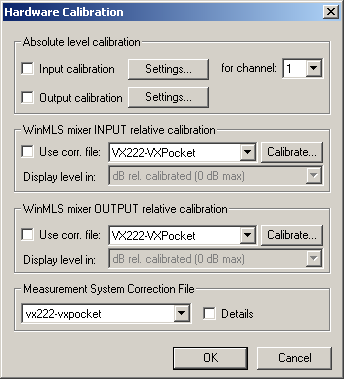
How to perform relative calibration of mixer input levels?
The WinMLS mixer controls the analog input and output amplifier of the sound card (some sound cards do not have a Windows mixer, and some cards have a mixer that can not be controlled by WinMLS). The relative calibration will generate a file containing the gain steps for the mixer, this file is used for correction when the mixer gain is changed. So when a relative calibration has been done for the WinMLS mixer, changing the volume of the WinMLS mixer input will not affect the level of measurement.
To activate relative calibration for the mixer, go to Measurement->Hardware Calibration.

In the dialog box shown above under WinMLS mixer INPUT relative calibration make sure  is checked. To the right of this check box, you can select the correction file to be used from a list of files.
is checked. To the right of this check box, you can select the correction file to be used from a list of files.

If you are using the sound card VXPocket or VX222, we recommend that you use the file VX222-VXPocket instead of generating a correction file.
To generate a new correction file, click the  button. This calibration procedure may take some minutes, all the gain steps of the mixer will be tested and measured. When finished, we recommend that you test the results by performing some measurements with different WinMLS input volume settings. This can be done by measuring the sound card loopback (input connected to output), plotting the frequency response (Frequency Response/Spectrum). Making sure that all the measurements have exactly the same level. Especially the lowest mixer levels should be tested since these may be influenced by noise. It is possible to edit the values by opening the calibration file e.g. using the Windows Notepad (it is a text file).
button. This calibration procedure may take some minutes, all the gain steps of the mixer will be tested and measured. When finished, we recommend that you test the results by performing some measurements with different WinMLS input volume settings. This can be done by measuring the sound card loopback (input connected to output), plotting the frequency response (Frequency Response/Spectrum). Making sure that all the measurements have exactly the same level. Especially the lowest mixer levels should be tested since these may be influenced by noise. It is possible to edit the values by opening the calibration file e.g. using the Windows Notepad (it is a text file).
If your sound card supports 24 bits, the use 24 bits for recording to get the best results (in Measurement->Sound Card Settings set Input number of bits: to 24). If you are doing a 2-channel measurement, the relative calibration for both channels is done using the same correction file. The mixer steps for channel 1 should be equal to channel 2, but we recommend that you test this.